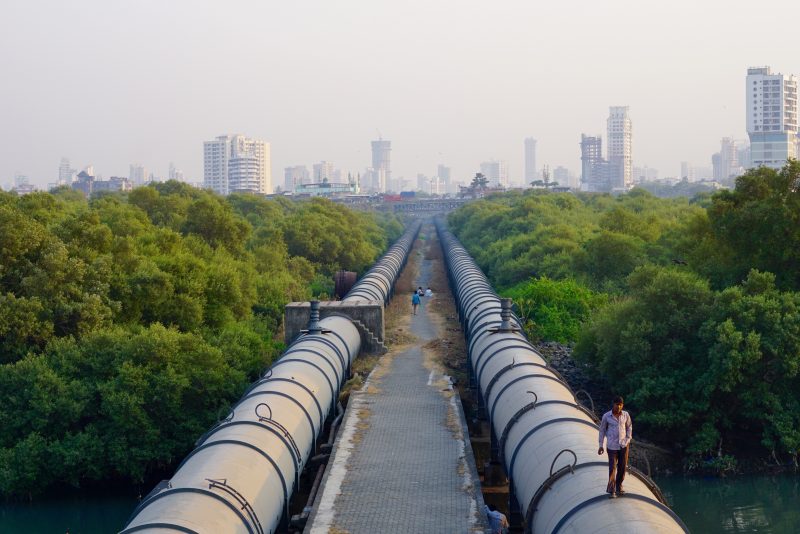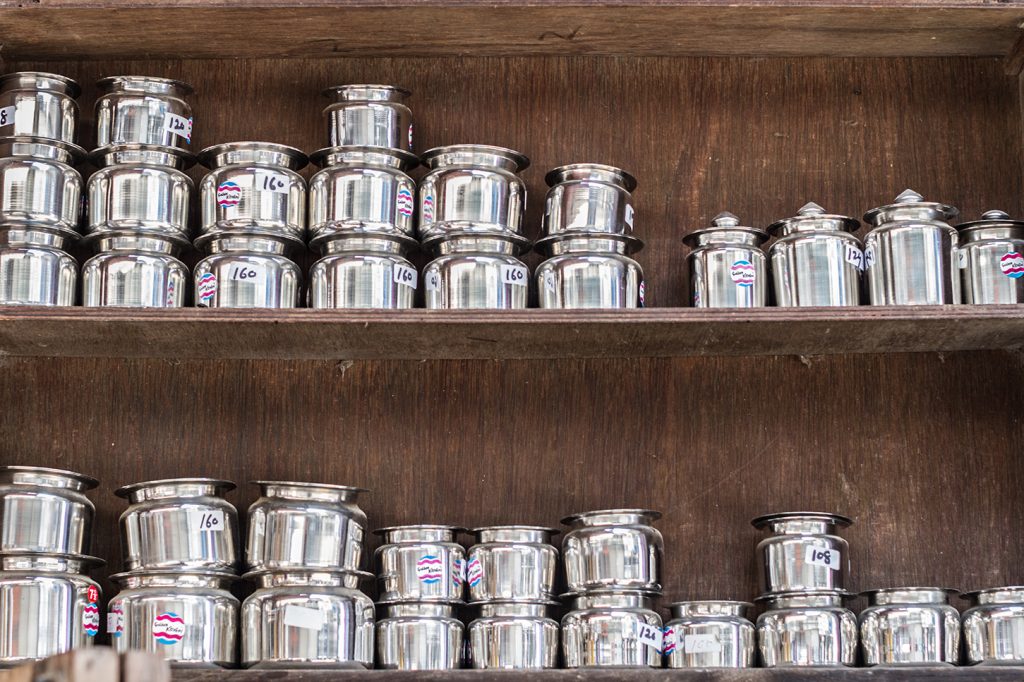Mumbai’s public water network has long distributed water, difference, and inequality in the city. The city’s hydraulic infrastructure, incrementally extended in the last 150 years, is today the sixth largest in the world. More than 7,000 city employees distribute nearly 3.5 billion liters of water daily by managing more than 4,000 kilometers of pipe. Their work makes possible the lives of more than 12 million of the city’s residents, and generates handsome revenue surpluses for the city. Yet if the ledgers of the city’s water department are overflowing with funds, maintenance works contracts, and, indeed, water, the city’s hydraulic network does not distribute water continuously to individual households for 24 hours a day. Instead, water is distributed only for a few hours a day, and only to “co-operative housing societies”—in slums and high-rises alike— that then deploy various technologies to gather and distribute this water among their members every day.
Between 2003 and 2009 the Municipal Corporation of Greater Mumbai (MCGM) delegated a team of World Bank–appointed management consultants, Castalia Advisors, to reform and “improve” the distribution regime in one ward of the city. During this time, the consultants attempted to control leakages in the ward, audit water flows, and sought ultimately to transform the network from an intermittent system of scheduled supply to one in which water would be available to residents and commercial users 24/7. They attempted to convert the existing system from one in which the quantities of water distribution were rationed by the water schedule to one in which consumption would be regulated by price (see also Collier 2011; von Schnitzler 2013). In so doing, they proposed to shift the locus of regulation from state engineers to water meters charging ‘rationalized’ prices. The consultants at Castalia insisted that with this change, water would be more efficiently and equitably distributed.
This effort failed spectacularly in 2008 for a variety of reasons, not least because the consultants were unable to stabilize their measures of water during the water audit (Anand 2015). The reform effort also ran into trouble when slum dwellers opposed the pilot project, both through their daily practices, and by insisting that water was a public good. Here, I draw attention the ways in which residents regularly demand water, as a public matter, in the offices of city councilors and public hydraulic engineers. Their demands describe the quotidian ways in which hydraulic publics are made and managed in the city.
As a fecund and generative term, “public” has a variety of meanings. In his careful classification of its various uses, Jeff Weintraub (1997) draws attention to four different ways to understand the term: (1) as public goods (as opposed to those distributed by the market); (2) as political communities distinct from markets and the state (as the Habermasian public sphere, or Warner’s (2002) counterpublics); (3) as a mode and space of stranger sociability that mediates between the bureaucratic realm and the space of the home (like Jane Jacobs’s (1961) “eyes on the street”); and finally (4) as a category that demarcates a split between the family/household/oikos (as private) and a larger political masculine order that is public (Arendt (2013). Adjacent to, but drawing on elements of these definitions of the public, I demonstrate how publics are brought into being though efforts to care for and maintain water, and the enduring effects of water distribution infrastructures in the city (Marres 2012).
Material Publics
Historians describe infrastructures as historical forms that emerged in the mid-nineteenth century to produce liberal forms of rule over citizen-subjects freed of the entailments of fragmentary political communities (Joyce 2003). As they proliferated both in the colony and the metropole, public infrastructures such as roads, water lines, and trains rearranged social collectives both in the country and the city. For example, the installation of public hydraulic infrastructure in Mumbai by the colonial government shifted publics from those congealing around the tanks, wells, and springs managed by wealthy native philanthropists to the taps, pipes, and political regimes of the colonial state (Dossal 1991). These colonial histories of public infrastructure continue to matter in postcolonial cities like Mumbai, and trouble the expectations of universal, undifferentiated service that frequently accompany accounts of public systems. The shifting history of the water infrastructure in the postcolonial city reveals how it has never produced a universal, homogenous public. Instead, the hydraulic public has long been plural—publics—and differentiated by different regimes, politics, and practices of infrastructure management in the city.

Figure 1: Hydraulic City. Water mains bring water from distant dams to the City.
Mumbai’s water network is structured to distribute water from large dams via trunk mains through secondary transmission lines to service lines. The reticulate form of the network distributes and gathers hydraulic publics in the city. On one hand, the nested scales of water distribution infrastructure allow the city water department to distribute different quantities of water to different regions of the city. On the other hand, to the extent that very wealthy and poorer residents often live alongside each other in the city, the city’s hydraulic zones cannot easily discriminate between different classes of residents living in the same neighborhood and serviced by the same pipe (Björkman 2015). If publics are formed and distributed by the material entailments of the water network, these publics are often surprisingly heterogeneous and difficult to distinguish along class or religious lines.
Public Performances
Publics are regularly reproduced through the quotidian maintenance and repair of water infrastructures in Mumbai. When water connections go dry, hydraulic publics today gather in the offices of city councilors (and not those of hydraulic engineers) to demand their share of water. Because city councilors in Mumbai owe their office primarily to the votes of those who live in the city’s settlements, they are extensively focused on redressing the discrete grievances of their constituents. Many of them keep their offices open to the public in the evening, when residents of the many settlements they govern can come to have their problems redressed, or at least heard. Residents visit councilor offices with different kinds of problems, including domestic disputes, school admissions, or health matters. Yet, as councilors would often point out, most of their constituents’ problems have to do with restoring water supply to their homes.
In the course of conducting fieldwork in 2007 and 2008, I documented several instances of such complaints in councilor’s offices. When water pressure dropped in their service lines, women first approached social workers to arrange a meeting with the city councilor (see Anand 2011). Because water connections were shared, and because the councilors often responded to their claims more expeditiously, women ensured they went to the councilor’s office as a “domestic public.” This gendered gathering alternately entreated, demanded, and shouted at councilors to make the water reappear, as it should, for the “public” [using the English word]. They made claims to water based on their kinship and/or friendship with those favored by the councilor. Councilors frequently noted their complaints and relayed them to the hydraulic engineer in charge of their ward, often at their next visit. Hydraulic engineers, recognizing that the approval of their works contracts was contingent on the good graces of city councilors, frequently found ways to solve these problems. Like councilors, engineers too recognized that their failure to resolve the problem would only make the complaints more vociferous. The city’s publics, after all, needed water not just to live and to vote, but also to allow engineers to do their work without disruption.

Figure 2: Pipe Publics. A gathering of water service lines in Mumbai.
Yet the engineers’ ability to fix problems was contingent on the “political situation” of the city’s water infrastructure (Barry 2013). The pipes, valves, and pumps that city engineers sought to fix to resolve one neighborhood’s water difficulty were enmeshed in social/material relations with several others in other neighborhoods. Thus, even when councilors and engineers agreed to fix, repair, or install new water pipes for disconnected residents, they needed to negotiate how (and from whom) they could redirect water to remedy the situation. As they moved water to quell the demands of a protesting public in one neighborhood, they would invariably generate new protests, new petitions, and new publics in another. These publics (like the ones that preceded them) would demand that it is the duty of the government to “at least” provide water to its citizens. Because it is vital to survival, water was thus often and easily made a public matter (Fennell 2016).
Conclusion
Publics are brought into being by the material and intimate political commitments to care about the enduring consequences of water distribution in Mumbai. Publics are situated and plural. They are formed around and by the materiality of the water network and its situated, regular, partial breakdowns in everyday life. Water infrastructures form and are formed by publics for whom water is a matter of life, and a matter for life. These publics emerge not only through associational relations between humans, but also through the various material infrastructures that are claimed, extended, and withdrawn through projects to govern the city. Public-ness therefore is not just an effect of human sociality, a political form that associates in already formed material worlds: publics are constituted through the distributed materialities that structure the city’s water infrastructure. As publics emerge through the situated materialities and designs of the hydraulic network, these more-than-human arrangements of the hydraulic network create enduring if unstable forms whose politics continue to matter after they have been constituted.
Thus, having learned how to approach the city’s authorities with their water problems—through collective, gendered petitions in the offices of councilors—residents of Mumbai’s settlements were understandably anxious about water reform projects in the city. City publics, particularly those living in the settlements, have established a predictable and knowable (if also discretionary) practice of claiming and demanding water in the city through discrete claims in the offices of councilors and engineers. Throughout the pilot project, consultants saw these quiet claims and discrete flows as leakage, a pathology to eradicate through liberal reforms that would “free” the system from interference by councilors and engineers (and their politics). Yet, in contrast, residents wondered aloud about how and to whom they might register complaints in the future if the city’s diverse water authorities were made redundant. In part, the pilot project failed to gather the support of the very residents for whom they claimed to be working because the proponents of privatization failed to recognize the vitality of water’s public forms in a differentiated city. Challenged by both the subjects and the experts of the city’s water system, the consultants’ pilot project was effectively deferred to an as-yet-unknown future. As a result, Mumbai’s water network today continues to generate known publics—differentiated communities of care—that demand the return of water amid (and from) mundane, ordinary disruptions in everyday life.
